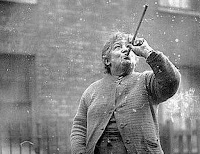What did you do before alarm clocks to wake up and make it to work on time?
In towns across England, workers would be roused from sleep by the sound of someone tapping at their bedroom window. On the street outside would be a figure wielding a long stick—the knocker upper.
The "knocker upper" was a common sight, in the towns
where people worked shifts, in mining communities, even in London where dock
workers, ruled by the tides, kept unusual hours.
Caroline Jane Cousins, known by many as "Granny" Cousins, was born in Dorset in 1841 and became Poole's last
knocker upper, waking brewery workers each morning until retiring in 1918.
Mrs. Bowers was a familiar sight in Sacriston, County Durham, where she and her dog, Jack, woke the miners working the early shift. She began knocking up during World War One and continued for many years. [Beamish, the Living Museum of the North] Take a look at the club she used.
Though the trade continued in a few places until the 1970s, the
spread of electricity and affordable alarm clocks meant knocking up died out in
most places by the 1940s and 1950s.
Knocking up was immortalized in songs such as this one written
by singer-song writer Mike Canavan, "The Knocker Upper Man":
"Through cobbled streets, cold and damp, the knocker-upper
man is creeping.
"Tap, tapping on each window pane, to keep the world from
sleeping..."
Tracy




A lovely spot of lost history, in jobs now no longer required. I confess I would have been the worst knocker-upper in the land as I hate mornings.
ReplyDeleteOh, me too! I've never been good at mornings.
DeleteSo interesting! I've read about this, in my studies of Victorian culture. My cats currently serve the same purpose. ;-)
ReplyDeleteBrilliant to have names and histories put to knocker-upers. I did know of them from my own mill history. (One of my great-aunts was a weaver and others were spinners)
ReplyDeleteFascinating! Great photos too!
Wow, I loved this post. Thanks for sharing and telling their stories. Doris
ReplyDelete